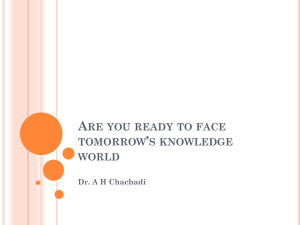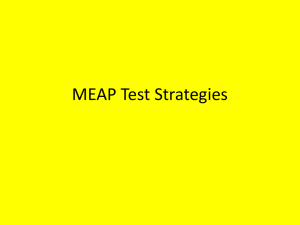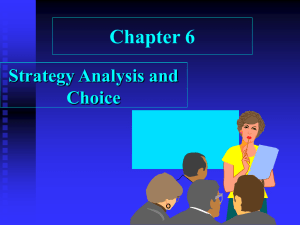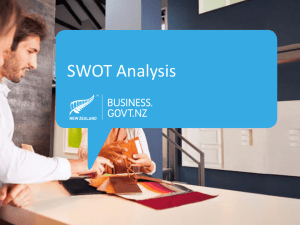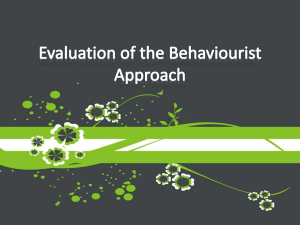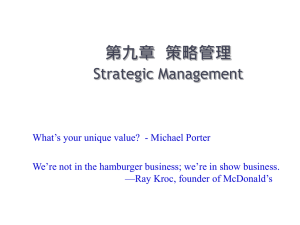Competitive Strategy
advertisement
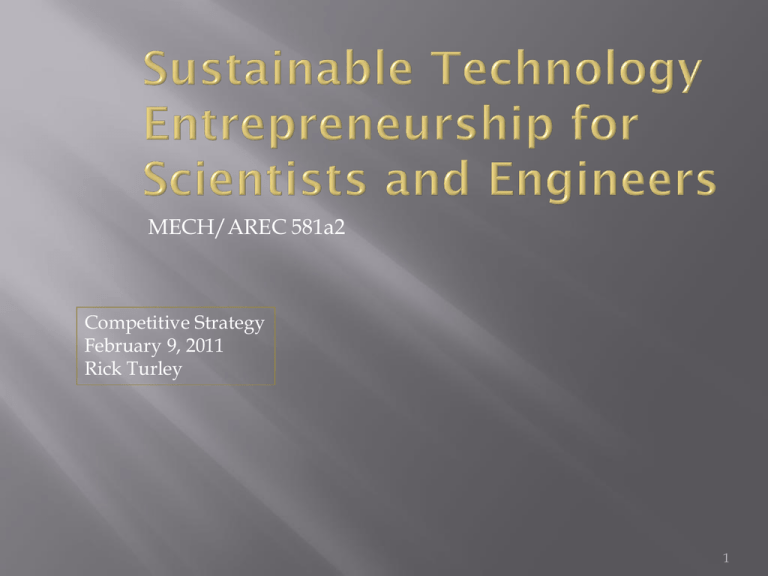
MECH/AREC 581a2 Competitive Strategy February 9, 2011 Rick Turley 1 Tools Value Proposition (handout) Technology Lifecycle (textbook) BMG Canvas (handout) 5/6 Forces (textbook) SWOT/TOWS (textbook) Value Chain (textbook) Triple Bottom Line (textbook) Whole Product Purchase Process (textbook) 2 We provide <product or service> to <target customer segment.> Unlike <next best competitor,> we offer <measurable differentiation/benefits/experiences> at <cost or price.>† See The Customer Value Proposition: Differentiation through the Eyes of your Customer, by Pamela Hudadoff at http://www.appliedproductmarketing.com/resources/CustomerValuePropositio nEssentials_eBook.pdf †Based on Building Market Focused Organizations by Lynn Phillips 3 A description of the experiences a target user will realize upon purchase and use of a product. Oriented around tangible and intangible benefits As measured by customer willingness to pay For a specific market segment Demographics Psychographics At a specific total cost/price 4 †Crossing A set of actual or potential customers, For a given set of products or services, Who have a common set of needs or wants, and Who reference each other when making a buying decision. the Chasm, Geoffrey A. Moore, Harper Collins, 1991, p. 28. 5 What is the Value Proposition for CSU? Who are “we?” Who is the Customer? What is the product/service? Who is the Next Best Competitor? What is our Differentiation? What is the Price? Cost? 6 What is an Elevator Pitch? http://www.youtube.com/watch?v=Tq0tan49rmc Succinct Easy to understand Greed induced Irrefutable Sources The Art of the Start, Guy Kawasaki Chapter 3, The Art of Pitching Made to Stick, Chip Heath & Dan Heath HBS Elevator Pitch Builder, http://www.alumni.hbs.edu/careers/pitch/ 7 8 Category Definition‡ Innovators First to adopt innovation; willing to take risks; young; high social class; social; scienceoriented; interact with other innovators Early Adopters High opinion leadership; younger; higher social status; advanced education; socially forward Early Majority Slower in adoption process; above average social status; contact with early adopters; some opinion leadership Late Majority Skeptical of innovation; below average social status; contact with late and early majority; little opinion leadership Laggards Last to adopt; little to no opinion leadership; aversion to change-agents; tend to be older; focused on traditions; lowest social status; contact with family and friends † http://en.wikipedia.org/wiki/Technology_lifecycle ‡ http://en.wikipedia.org/wiki/Diffusion_of_innovations 9 † http://en.wikipedia.org/wiki/Product_life_cycle_management 10 † http://en.wikipedia.org/wiki/Diffusion_of_innovations † http://en.wikipedia.org/wiki/File:Technology-Adoption-Lifecycle.png 11 Alex describing the tool on youtube: http://www.youtube.com/w atch?v=dtfNsuP2AQQ&featu re=player_embedded (8:12) 12 13 Source: Michael E. Porter, Competitive Advantage (New York: Free Press, 1985) Threat of New Entry Bargaining Power of Suppliers • Differentiation of inputs • Switching costs • Presence of substitute inputs • Supplier concentration • Importance of volume to supplier • Cost relative to total purchases • Impact of inputs on cost or differentiation • Threat of forward integration • Economies of scale • Proprietary product differences • Brand identity • Switching costs • • • • • Capital requirements Access to distribution Absolute cost advantages Government policy Expected retaliation Rivalry Among Existing Competitors • Industry growth • Fixed costs / value added • Overcapacity • Product differences • Brand identity • • • • • • Switching costs Concentration and balance Informational complexity Diversity of competitors Corporate stakes Exit barriers Threat of Substitutes Bargaining Power of Customers • • • • • • • • • • • Buyer concentration Buyer volume Buyer switching costs Buyer information Ability to integrate backward Substitute products Price / total purchases Product differences Brand identity Impact of quality / performance Buyer profits • Relative price performance of substitutes • Switching costs • Buyer propensity to substitute 6th Force: Other Stakeholders: Relative Power of Unions, Governments, … 14 How does this relate to Porter’s 5-Force Model? 15 Strengths, Weaknesses, Opportunities and Threats Internal Environment Strengths & Weaknesses External Environment Opportunities & Threats Internal Analysis (Organizational) External Analysis (Environmental) Strengths Opportunities Weaknesses Threats 16 17 Corporate Culture Market Position / Marketing Mix Financial Strength R&D Capability Technology competence Technology transfer Product Development People 18 †Business Model Generation, Osterwalder & Pigneur, Wiley & Sons, Inc., 2010, p. 214. 19 Strengths (S) List 5-10 internal strengths here Weaknesses (W) List 5-10 internal weaknesses here Opportunities (O) List 5-10 external opportunities here SO Strategies Generate strategies here that use strengths to take advantage of opportunities WO Strategies Generate strategies here that take advantage of opportunities by overcoming weaknesses Threats (T) List 5-10 external threats here ST Strategies Generate strategies here that use strengths to avoid threats WT Strategies Generate strategies here that minimize weaknesses and avoid threats Internal Factors External Factors ↓ †Essentials of Strategic Management, 5th Edition, Hunger & Wheelen, Prentice Hall, 2011, p. 77. 20 †Business Model Generation, Osterwalder & Pigneur, Wiley & Sons, Inc., 2010, p. 215. 21 Product Leadership “Best Product” “I want the latest, greatest thing” The Customer’s view: Operational Excellence “Best Cost” “I want it fast, easy, reliable,and cheap” Minimum To Compete Customer Intimate “Best Total Solution” “They understand and serve my every need” 22 Customers will buy from the supplier that best serves their needs in three basic value dimensions Operational Excellence leaders make you confident that you are getting the most reliable product or service at a very reasonable price Customer Intimacy leaders know every detail about their customers and tailor each product or service exactly to the needs of that individual or small segment Product leaders make you confident you are getting the best, latest, most advanced or most sophisticated item in the product category Treacy and Wiersema selected these three vectors from the study of hundreds of companies through the Sloan School at MIT and the CSC consulting organization 23 Lead in price and convenience Product Leadership Optimize all business processes “Best Product” Dell: Global supply chain, never make a PC before it is sold, only make the specific PCs the customer has bought, direct sales Wal-Mart: Information systems, supplier management, inventory management, secondary markets Redefine world class for the best cost/value shopper Operational Excellence “Best Cost” South West Federal Express GE White Goods Customer Intimate “Best Total Solution” 24 Lead in special/custom individual needs satisfaction Product Leadership Optimize processes to maximize lifetime value “Best Product” Home Depot: Sales clerks are experts in their area, stay with a customer until they are satisfied, train if needed Frito-Lay: Sales people stock every store themselves based on sales, great flexibility to create programs for supermarket customers Redefine world class for the perfect solution for me customer Operational Excellence “Best Cost” MBNA Staples USAA Customer Intimate “Best Total Solution” 25 Product Leadership “Best Product” Apple Sony Nike Lead in satisfying the need for the latest and greatest Optimize processes to minimize product development cycle Intel: Structured to obsolete its own products before competitors do, must drive Moore’s law Nike: Change the definition of the newest and best 3 to 4 times a year, always be one generation ahead of competitors Operational Excellence Customer Intimate Redefine world class for the early adopter customer “Best Cost” “Best Total Solution” 26 Map each of the following onto the model Your target customers Your competitors Your competencies Product Leadership Your time “Best Product” Your capital Your expenses Your brand image Your channels Does this make sense? What do your process produce? Operational Excellence “Best Cost” Customer Intimate “Best Total Solution” 27 Know where you are on your industry value chain and who has power Raw Material Primary Manufacturing Fabrication Product Producer Distributor Retailer Where is the industry in terms of evolution? Fragmented Industry: No firm has large market share and each firm serves only a small piece of the total market in competition with others – young industry Consolidated Industry: Dominated by a few large firms, each of which struggles to differentiate its products from the competition – older industry 28 Generic Product Expected Product Product with maximum chance of meeting needs – “Product” Potential Product †The What the consumer thought they were buying – minimum configuration meeting needs Augmented Product What is shipped in the box – covered by purchasing contract – “Device” Product’s room for growth Marketing Imagination, Theodore Levitt, Free Press, 1983, p. 79. the Chasm, Geoffrey A. Moore, Harper Collins, 1991, pp. 108-110. ‡Crossing 29 30 It’s all about differential value Meaningful to the customer, and Their willingness to pay There are a broad range of tools for analyzing competitive advantage The BMG Canvas pulls it all together 31 Apply these tools to your business proposal. Venture Challenge Complete Venture Challenge Assignment #2 from last week Complete Venture Challenge Assignment #3 (Byers p. 105) Mission Statement Opportunity Assessment Value Proposition Draft Business Model Develop SWOT analysis Select strategic approach Create partnership strategy Craft an “Elevator Pitch” If appropriate, describe social and environmental aspects Get ready for next week Read Byers Chapter 5 and sections 11.8 & 11.9 32


